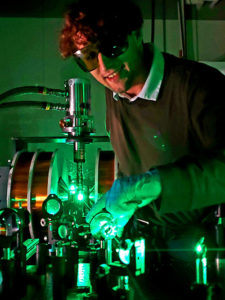 The University of Tennessee, Knoxville, has had a solid run of success of students being selected for the US Department of Energy’s (DoE) Office of Science Graduate Student Research (SCGSR) Program.
The University of Tennessee, Knoxville, has had a solid run of success of students being selected for the US Department of Energy’s (DoE) Office of Science Graduate Student Research (SCGSR) Program.
In fact, since the program’s beginning in 2014 UT has had 21 graduate students chosen for participation, the second most of any university. Make that 22, as Bogdan Dryzhakov, a graduate student in the Department of Materials Science and Engineering (MSE), was selected Monday.
He works with Professor Bin Hu of MSE at UT and with Oak Ridge National Laboratory (ORNL) Corporate Fellow for the Center for Nanophase Materials Sciences (CNMS) Sergei Kalinin. With them, Dryzhakov conducts research focused on ferroelectricity, which looks at how electric fields can change polarization of certain materials.
“Our research will investigate the ferroelectric-optical coupling phenomenon using advanced scanning probe microscopy at CNMS and ultra-fast spectroscopy at the UT-ORNL Joint Institute for Advanced Materials,” said Dryzhakov. “Essentially, we propose that if we engineer ordered excited states then they can couple and contribute to the crystal’s ferroelectricity, leading to extraordinary excited state dynamics.”
Dryzhakov said that one of the things that sets UT apart from others is the chance to work closely with both the university and with ORNL, noting that it is a “unique and invaluable” part of his doctorate and experience at the university.
As a graduate student, he said that he already feels fortunate to have worked with a number of well-respected researchers, and that this new opportunity could open even more avenues of research and discovery.
“I hope that this experience broadens my understanding of the connection between nonlinear optics and opto-electronic properties and allows me to directly characterize the ferroelectric-optical coupling, especially its effect on excited state dynamics,” Dryzhakov said. “This award provides an 11-month opportunity to collaborate on a much deeper level and gives me the chance to have training using functional atomic force microscopy.”
Being able to pursue scientific innovation is so important to him, in fact, that it is one of his biggest factors when considering life after graduation.
“I am passionate about device innovation and new physical phenomenon discovery,” he said. “I hope I can continue researching something cool and well-funded. The location, private or public, is not particularly important to me, but the impact of the work and the freedoms I am allowed are.”
This year’s SCGSR class is made up of 65 students representing 29 states. The goal of the program is to prepare students in STEM fields that are critical to the continued success of the DoE.
Students were selected based on how well their proposal fits DoE needs and plans, and are designed to help strengthen the students’ thesis ideas while providing research opportunities at DoE facilities and with DoE scientists.
The program includes supplemental support to allow students the chance to spend between three months and one year at a DoE lab, including a stipend of up to $3,000 per month.